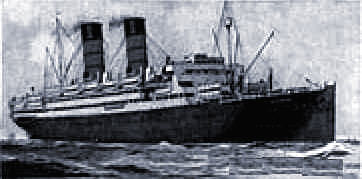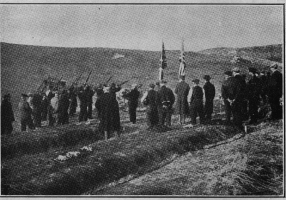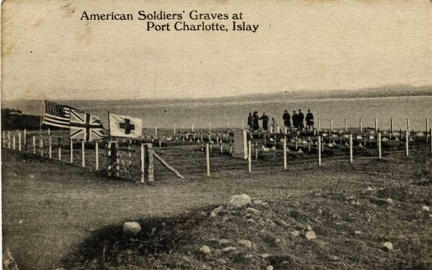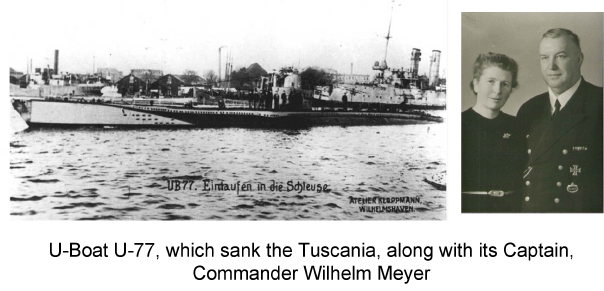Member Login
Free Search
Enter First Name, Last Name or Full Name and click Search,or click on the Advanced Search link for more options
Famous Scots - John Sloss




On February 4th, twelve days out, while west of Ireland we were met by eight British destroyers whose presence did much to ease the minds of those who feared a brush with the Germans. On the afternoon of the fifth we had rounded the north of Ireland and were proceeding southward.
On either side we could dimly discern the cliffs of Scotland and those of the rocky Irish coast from which we judged we were in mid-channel and about thirty miles from land. Dusk came early and at five thirty the night was quite dark. Shortly before six - most accounts say thirteen minutes to six - the thirteenth day out of New York, the first troopship carrying American soldiers was torpedoed. The earliest knowledge we had of the proximity of a German submarine was a decided shock which rocked the big ship from end to end. Simultaneously all lights went out and a deafening crash echoed and re-echoed through the ship. There was no question we had been hit, and so, life belts on, we rushed for our stations.
Our boat drills had been perfunctory ones at the best, merely locating the lifeboats assigned and taking our places quickly, but in an orderly manner. Before the crash had died away every man was on his way to his post. The corridors, passage ways and stairways were a seething mass of olive drab streaming for the decks. The rush was devoid of all hysterical excitement. Each man was excitedly cautioning his neighbor to " take it easy, 'don't rush," ''don't crowd; she isn't sinking''; yet he was using his elbows, feet and hands in regular mess-line tactics to further a speedy arrival at his lifeboat. From the lowest deck - the troops occupied five?to the first cabins, a steady stream of men?and profanity?issued. In ten minutes practically every able bodied man was at his post. Then we began to take stock and find out what had really occurred.
The torpedo had struck us squarely amidships on the starboard side. A great hole was torn in the hull and all the superstructure directly above was reduced to a mass of wreckage. Several sets of davits with their lifeboats were utterly demolished, thus diminishing the chances of getting away safely. From the minute of the explosion the ship began listing to starboard. It became exceedingly difficult to walk on deck, and more than one of the boys on losing his grip on the port rail would find himself sprawled against some of the deck machinery, a keg of rope or even the rail on the lower side. These ten or fifteen minutes elapsing from the moment we were struck were filled with action. With all indications of a speedy sinking staring us in the face, we worked feverishly to lower the lifeboats and cut away the rafts. Pitch darkness made our work more difficult.
Here and there a pocket flashlight came into play. Later the auxiliary lights were turned on and we could better see what there was to do. The work of lowering the lifeboats proved discouraging. Not only had we lost several, due to the terrific effects of the explosion, which had thrown a sheet of flame and debris two hundred feet into the air, but we discovered boat tackle in many cases to be fouled or rotted and unfit for use. Some of the first boats we attempted to lower were capsized in midair, spilling their occupants into the icy water. The high seas running and the darkness made the rescue of these men almost impossible. Occasionally we got a boat away in good nothing more serious than sprung planks or missing rain plugs.
These difficulties were overcome by bailing with service hats which served the purpose very well. On the port side the launchings were accompanied with another handicap. The Tuscania had acquired such a list that we found it necessary lifeboats down the rivet - studded sloping side of the ship with the aid of oars as levers. In all some thirty lifeboats were launched, and perhaps twelve of these were successful. After acquiring a heavy list, the Tuscania seemed to sink no lower in the water. Of those on board, though, the haste to go somewhere else abated not a bit. With the lifeboats gone together with the rafts, the situation looked none too encouraging. The boys showed few signs of nervousness. Standing there, lining the rail, waiting for the next development, some six hundred of them smoked or talked quietly, discussing their plight. The remarkable part of it all was that they took everything in a matter - of - fact way with a sort of ''well, what's next?'' attitude. Occasionally few would sing some little song, indicative of their feelings, such as ''Where Do We Go From Here, Boys?'' or "To Hell with the Kaiser.'' The absence of any panic, or effort and time in prayer was notable. A casual observer might, had he acquired a few snatches of the conversation, have thought the latter practice was being indulged in. A closer observer would have revealed a collection of wonderful expressions from vocabularies replete with all the known cuss words in existence. The objects remarks were chiefly the U-boats, the Kaiser, the Germans and the authorities criminally neglectful of the safety of the troops. With all the lifeboats gone, a general wonder as to the next move was voiced. Suddenly on the starboard, out of the darkness, a tiny destroyer came sidling up to the troopship. With a display of seamanship nothing short of marvelous she approached near enough for the men to be transferred to her deck. Some times almost hidden by the roll of the big ship, the destroyer clung to us.
Ropes were let over the side and several hundred of the boys went over. When the destroyer was loaded to the limit she steamed away, leaving a few boys dangling to the sixty foot ropes. It was here that one of our cooks, a two - hundred pound specimen, surprised us all and no less himself, by climbing all the way up to the deck again. When asked to demonstrate his feat a few days later in our Irish camp, he was unable to climb the height of the rafters in our barracks. Click the image for a letter written by a Tuscania survivor, vowing revenge; from Southern Lumberman, March 23, 1918 Shortly after the departure of the destroyer-load of troops another one sidled up to us and completed the work of rescue. She, too, was crowded to the limit; but she stayed till every known person on board had been transferred. No sooner had she pulled away when some of the longitudinal bulkheads gave way, admitting the water to the port holds. Slowly the Tuscania resumed on even keel. Very low in the water and considerably so in the bow, she floated for another hour. At about ten o'clock, four hours after being struck, she took her final plunge.
With a muffled explosion as the water reached her boilers, she gently slid, bow first, under the surface. During all this time the lifeboats and rafts were drifting helplessly about. It was impossible to make any headway with the oars, as most of the boats were full of water, and there was such a heavy sea that any such effort was useless. In and out among these boats the destroyers raced, looking for traces of the submarine and dropping depth bombs where there were any suspicious indications. Each time one of the "ash cans'' exploded the boats would shiver and shake with the concussion. Those men who were in the water were knocked breathless with each explosion, and in a few cases were rendered unconscious. The noise of the depth bombs, the bursting of the distress and illuminating rockets, together with the reports from the destroyer's deck guns, created the impression that a naval battle was in progress. Most of the boys, and they had some excuse for their belief, were sure we were being shelled by the Germans. However, later information convinced us that the submarine had left the vicinity immediately following its successful attack on our convoy.
While the work of abandoning ship was in progress were added to by a number of trawlers and smaller fishing boats which helped in gathering in the survivors. These together with the destroyers combed the vicinity picking up men in lifeboats and rafts. Each bit of wreckage was closely scanned on the possibility of there being someone clinging to it. In this way the majority of the living were rescued. A few swimming alone and helpless were left. Darkness and the wide area the rafts and boats were scattered made it impossible to find them all. Three lifeboats, each more than filled with its complement of men, were overlooked. Among the first the big ship, they had drifted quite a distance before the rescue work had fairly commenced. With no guidance and at the mercy of the wind and waves they drifted aimlessly for hours and then were dashed upon the cliffs of the Isle of Islay, Scotland. Out of more than sixty men in one of these boats but eight were saved. It was here that the greater part of our loss was sustained. The coast upon which many soldiers of the 6th Battalion were lost. The monument to those who died in the Tuscania sinking can be seen at the top of the cliffs.
A combined search for the submarine and survivors was kept up until early morning by the torpedo boat destroyer and trawlers. When it seemed as though further search was useless they entered various ports of the north of Ireland. The men were landed chiefly at Londonderry, Larne and Buncranna. A few were scattered at various other places in along the coast and also in Scotland. In a week's time we had located our different groups of saved and again resumed some sort of organization. At this time we left for Winchester, England, where we were stationed for five weeks.
This time was used in getting us supplies of equipment and clothes, of which we had none to spare. Many of the men were dressed in British sailors uniforms and even civilian clothes. Finally we were made presentable enough and were permitted to sail for France and take our place so long waiting for us.
Headstone Photograph

Further Information
Firstname: JOHN
LastName: SLOSS
Date of Death: 5th Feb 1918
Age at Death: 33
Cemetery: Lochwinnoch Cemetery
Linthills Road
Town: Lochwinnoch
Region: Glasgow and Clyde Valley
Country: Scotland
Please Note, the marker on this map indicates the Cemetery location, not the location of a particular grave.
<< Back



